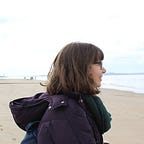#4: The Book
When we started this blog, I made a vow that my chosen object would never be a book, and yet here I am, taking a picture of the bookyist book I could find.
You see, when I analysed my instinctive belief that choosing a book would be some sort of cop-out, it actually became pretty interesting.
A book is not an object. At least it does not seem an object to me in the same way a typewriter or an old car seat does. Yes, you can hold it, feel it, smell it. Yes, it is a physical entity. But a collection of paper that you can see and touch is so clearly not what a book is.
A book is a vessel. If I were to talk to you about a book, I would not talk long about the font, the paper, the cover; I would talk to you about what was inside it, perhaps about a group of hobbits and the absolutely insurmountable amount of walking they do.
While a typewriter exists to type and a seat exists to be sat on, a book can teach, preach, entertain, scare. The thing that a book is, its essence, is beyond the object itself.
This distinction can be defined as such: the ‘text’ is the story, while the book is the object as a physical whole. It is this separation that allows someone reading an ebook, someone reading a paperback, and someone reading a hardback, all to be able to say that they have read Jane Eyre.
This idea applies to other objects: a DVD, a CD, my laptop. All exist simply to take you somewhere beyond the object itself, be that the glittering, musical landscape of a Debussy track, or the shining pixels of the internet.
This blog finds interesting, intangible associations with physical objects, but a book is already bound to the intangible. A book can take you to Narnia and a mobile phone to the strange faces of Snapchat. However, you are then not interested in the book or the phone, you are looking at a text and an app, non-physical objects that exist outside the vessel you experience them via.
But back to Jane Eyre. Did those three people really read the same book? If the font was more cramped, would one book not seem more intellectual than the other? If one had a cover with an image of ‘Jane’ on, would that reader not subconsciously see this figure as they read? How much does the physical object of the book affect the text?
These are the sort of questions I have never asked in my English literature degree, but they are commonplace in the publishing house. Are they purely a question of marketing, or are they something more profound? When a publisher rereleases a text in a new cover, altering the ‘vessel’, have they also altered the text? Is the book and text bound together as an inextricable whole?
It turned out that writing about a book was not a cop-out at all; it became instead a deconstruction of the term object.
Some objects have a use applicable to all objects under that name (all typewriters are made to type), while others are simply vessels, carrying an intangible object (a text, a film, an app) that has a purpose of its own.
Objects are more indefinable than even our creative definition suggests.
